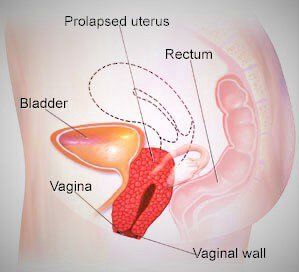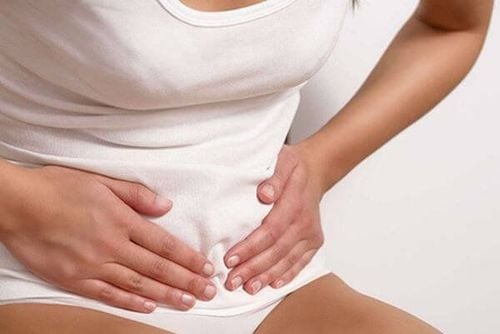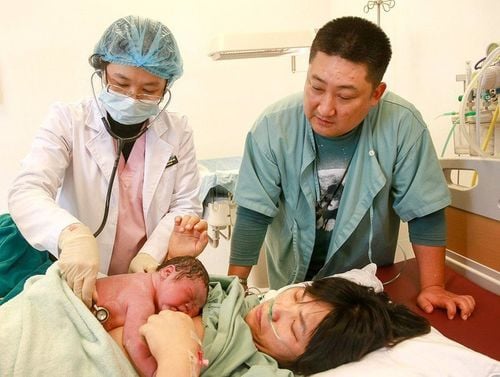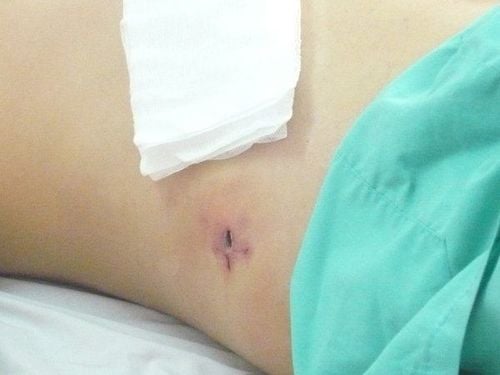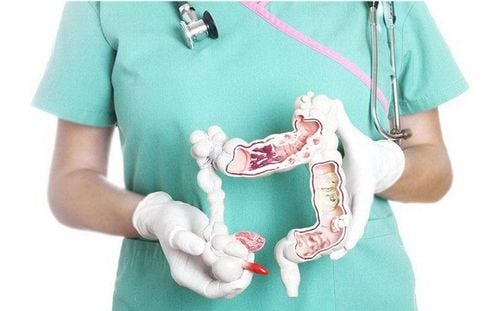This is an automatically translated article.
The article is professionally consulted by CKI Doctor Tran Thi Phuong Loan - Department of Obstetrics and Gynecology - Vinmec Phu Quoc International General Hospital
Pelvic floor dysfunction, loss of urinary and stool control, osteoporosis, back pain... are common problems after giving birth. Postpartum rehabilitation will help pregnant women recover effectively after pregnancy, get healthy soon, return to normal activities and be happy with their families.
1. When to start rehabilitation for new mothers?
Postpartum mothers can begin rehabilitation at any time, including during their hospital stay. Specifically:
For pregnant women with acute symptoms after childbirth or complicated vaginal delivery, the obstetrician may prescribe immediate rehabilitation. Otherwise, 4-6 weeks or more after vaginal delivery, the obstetrician will recommend that the mother begin rehabilitation. Women who have had a cesarean section can start the program from the 8th week or more from the time their baby is born. In particular, women should contact the postpartum rehabilitation team if they notice the following symptoms:
Pelvic floor pain Back or neck pain Sciatica Joint pain Severe fatigue Mood disorders Menstrual pain In addition, the physiotherapist also guides the mother to perform exercises in case of:
Urinary incontinence, leaking urine when coughing, laughing or sneezing Feeling of heavy and weak pelvic floor Urinating or bowel disorders Convenience Pain or dryness of the vagina during sex Scars Fatty swelling, abdominal distension due to muscle relaxation Back or pelvic pain Tired of baby care or work Difficulty controlling or weak muscles Even without any strange symptoms After giving birth, mothers can still go to a medical facility to evaluate their body functions, make sure their internal organs work as they should and optimize their strength.
Where a woman wants to return to intense sports, her obstetrician will recommend early initiation of a new mother's rehabilitation program with qualified medical staff.

Các bà mẹ sau sinh có thể bắt đầu phục hồi chức năng vào bất kỳ lúc nào, kể cả trong thời gian nằm viện
2. Effect of postpartum rehabilitation program
During pregnancy, the pelvis, abdomen and spine change quite rapidly to accommodate the growing fetus. This is the reason why new mothers often feel pain or discomfort in the back, pelvic floor and abdomen. In order to overcome these changes, and at the same time complete the care of the baby and family, as well as prepare to return to work, new mothers need to be supported by an experienced postpartum rehabilitation team. step by step.
Physiotherapists will work together to create a program tailored to your specific health needs and condition, including:
Managing pain in the uterus, back, neck or legs Adjusting posture, pelvis and spine Massage, chiropractic with gentle movements to balance the pelvis, harmonize the nervous and endocrine systems Exercise to strengthen and stretch the pelvic floor muscles, restore posture, abdominal muscles and posture breathing Rehabilitation of postpartum urinary retention, incontinence, and urgency A guide to safely performing daily activities for postpartum women. Postpartum rehabilitation helps new moms feel more confident, knowledgeable about their pelvis, and return to physical activity quickly and safely, including sex and playing sports. During your new mom's rehabilitation, you'll also learn how to take control of your body, to prevent secondary complications from occurring weeks or months after returning to life. The program also prevents complications - such as spinal and pelvic pain, which can occur months or years after giving birth, and reduces the risk of urinary incontinence or uterine prolapse at menopause.

Phục hồi chức năng sau sinh giúp người mới làm mẹ tự tin hơn
3. Postpartum exercises for quick recovery
At the obstetrics department, don't hesitate to talk to your doctor or midwife if you have any concerns. Must exercise early, get out of bed and walk to promote blood circulation, prevent blood clots. But if you exercise in the wrong way, inappropriate vigorous exercise will risk injury, negatively affecting the body and quality of life. Immediately after giving birth, the following exercises can be started:
In bed
Ankle flexion - extension: Repeat the movement 6 times, do 5 times / day Gently and slowly bend one leg, alternating foot. Repeat the movement 4 times, do 5 times / day Lift the pelvis gently to relieve back pain. Repeat the movement 4 times, do 5 times a day Apply ice packs to reduce swelling or pain of the pelvic floor and hemorrhoids. Frequency of 10 minutes every hour, for 1-2 days after giving birth Kegel exercises in the lying position, contract the pelvic floor 3-4 times to help blood circulation and healing. Gently squeeze in then release, no need to hold tight. Squeeze the pelvic floor before coughing or sneezing. Women who have had a caesarean section should use their hands to support the abdominal incision. Getting in and out of bed
Need help from a midwife when getting out of bed for the first time after giving birth, in order to avoid the risk of falling and damaging injuries, if any Apply the same method of moving from the side position as when pregnant to avoid spinal and abdominal pain DO NOT sit up straight while lying on your back. Sit in a chair
Sit in a comfortable chair while breastfeeding Avoid prolonged sitting on a round mattress, although this pillow helps to relieve pelvic floor discomfort Listen to soothing music to relieve stress Relax your shoulders and neck, rotate the shoulder joint front - back several times. Go to the toilet
Sit comfortably on the toilet, keep your waist flexed as you lean forward to relieve pressure on the pelvic floor Put your hands on your thighs, support your abdomen to relax forward Use a footrest and hip flexion to protect the pelvic floor Breathe slowly, do not hold your breath and put pressure on the pelvic floor. Use your hands to support the incision and perineum when necessary.
During exercise, the mother must always listen to her body, do not stretch, and silently endure pain or discomfort. Arrange rest and walk time according to your baby's sleeping rhythm.

Phục hồi chức năng cho bà mẹ mới sinh là cách tốt nhất để lấy lại vóc dáng
4. Get in shape after giving birth
Women can't get in shape right away during the postpartum period, so it's important to understand how to properly recover, rest and take care of yourself. Postpartum mothers should take time for their body to heal and recover, doing little work in the first 3 weeks.
After rehab for new mothers, the best way to get in shape is to combine exercise with a healthy diet. If you plan to take yoga or fitness classes after giving birth, wait at least a month and contact a medical professional for a full evaluation before starting. Avoid swimming too soon because of the risk of infection.
Light exercise, minimal housework, avoid heavy lifting or travel. Ask your husband to support and keep your wife's correct posture while bathing and taking care of the baby. Avoid intense workouts that lead to burnout. You should incorporate exercises into your daily life, making exercise fun. Do not force the body, just start walking slowly and gradually increase the time when you feel comfortable, combining pelvic floor contraction exercises. You can start with light activities such as walking, cycling, swimming or light jogging and then gradually increase. During the first year of life, priority should be given to participation in social activities over competition or competitive sports. When the baby is born, the mother will see and feel many of her changes, from weight, body shape, mobility, mood to strength. If you know how to exercise, self-assess the recovery process and limit pain, postpartum women will be healthier. But postpartum rehabilitation cannot be rushed, but will progress step by step so that women soon return to an active and exciting life.
Newborns from 0 - 6 months old are generally prone to respiratory diseases, gastrointestinal infections if they eat solid foods early or the storage and preparation of milk is not guaranteed. To protect children's health, parents should do well to exclusively breastfeed their babies for the first 6 months (if possible) and vaccinate on schedule. As soon as a child shows symptoms such as anorexia, fatigue, and crying, the child needs to go to the hospital to be consulted by a specialist for monitoring and treatment. The pediatric department at Vinmec International General Hospital is the address for receiving and examining diseases that infants and young children are susceptible to: viral fever, bacterial fever, otitis media, pneumonia in children. With a system of facilities, modern medical equipment, sterile space, minimizing the impact as well as the risk of disease spread, Vinmec will bring satisfaction to customers. and is highly appreciated by industry experts with:
Gathering a team of leading pediatricians: including leading experts with high professional qualifications (professors, associate professors, doctors, Master's degree), experienced, worked at major hospitals such as Bach Mai, 108.. The doctors are all well-trained, professional, conscientious, knowledgeable about young psychology. In addition to domestic pediatric specialists, the Department of Pediatrics also has the participation of foreign experts (Japan, Singapore, Australia, USA) who are always pioneers in applying the latest and most effective treatment regimens. . Comprehensive services: In the field of Pediatrics, Vinmec provides a series of continuous medical examination and treatment services from Newborn to Pediatric and Vaccine,... according to international standards to help parents take care of their baby's health from birth to childhood. Advanced techniques: Vinmec has successfully deployed many specialized techniques to make the treatment of difficult diseases in pediatrics more effective: neurosurgery - skull, stem cell transplant blood in cancer treatment. Professional care: In addition to understanding children's psychology, Vinmec also pays special attention to the children's play space, helping them to play comfortably and get used to the hospital's environment, cooperate in treatment, improve the efficiency of medical treatment.
Please dial HOTLINE for more information or register for an appointment HERE. Download MyVinmec app to make appointments faster and to manage your bookings easily.
Reference sources: fvhospital.com, upmc.com



